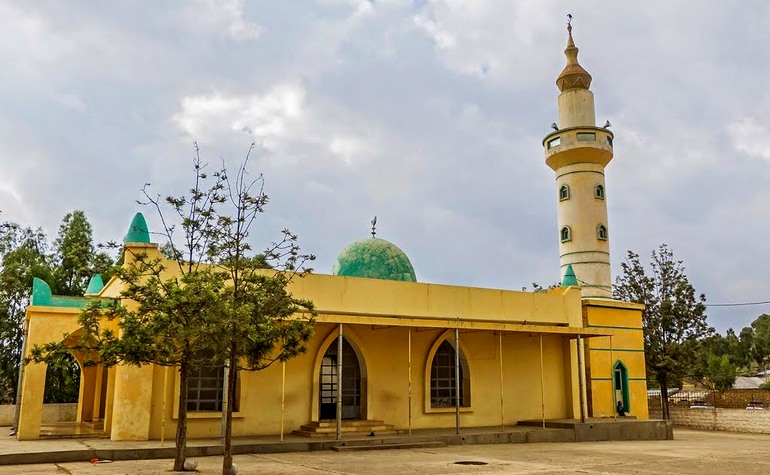This mosque (masjid) is located in the city of Negash in northern Ethiopia and is located in the area where righteous Ashama Ibn Abjhar (King Negus) lived during the time of the Prophet (saw). He gave shelter to two groups of Sahabah, the Companions of the Prophet (saw) who migrated there because of the persecution of Quraysh in the early history of Islam.
After much suffering at the hands of Quraysh in Mecca, the Prophet (saw) ordered a small group of Muslims to make a Hijra (migration) to a safe place in the country of Abyssinia. (which known as Ethiopia now). At that time, Abyssinia was ruled by a Christian king (who later converted to Islam), known for his mercy and justice, whose name was Negus. They were confident that they would receive protection and worship and live in peace there.

In Rajab of the fifth year of the Mission (614-615 CE), the first group emigrated to Abyssinia. The group consisted of about twelve men and five women, which included Uthman (may Allah be pleased with him) and his wife Ruqayya (may Allah be pleased with her) daughter of the Prophet (saw). The Quraysh pursued them to the port of Shuaiba by the Red Sea to capture them, but their ships left the coast. When the group reached Abyssinia, they heard a rumor that the entire Quraish tribe had converted to Islam. Naturally, they were very pleased with the news and returned to their country. Approaching Mecca, they learned that the rumor was false, and the persecution did not stop. Some of them decided to return to Abyssinia, and the rest entered Mecca in search of the protection of several influential people. This is known as the first migration to Abyssinia.
Later, a large group of 83 men and 18 women emigrated to Abyssinia, led by Jafar bin Abu Talib (may Allah be pleased with him), the Prophet’s cousin (saw). This is called the second emigration to this country, and some Sahabahs took part in both migrations. Qureysh did not like emigration, and the thought of the world used by the fugitives did not give them peace. They sent a delegation to Abyssinia headed by Amr ben Aas (not a Muslim at the time) with beautiful gifts for the king, his courtiers and the clergy. First, the delegation met with the leaders and priests, and by offering them gifts, managed to attract judicial officials to their side.
When the king gave an audience to Quraysh, Amr Bin Aas said that the Muslims in Abyssinia were not refugees from persecution, but were fugitives from justice and the law, and asked the king to extradite them to Mecca. The king, however, wanted to hear the other side of the story before making any decision, and called Jafar (may Allah be pleased with him) to court to answer charges against Muslims. Jafar (may Allah be pleased with him) made a memorable defense, addressing the Christian king, who he said: “O king! We were ignorant people and lived like wild animals. The strong among us lived hunting the weak. We did not obey any laws and did not recognize any authority except the authority of brute force. We worshiped idols made of stone or wood and knew nothing about human dignity. And then God, by His Grace, sent His Messenger to us, Prophet Muhammad (saw) who himself was one of us. We knew about his truthfulness and his honesty. His character was exemplary, and he was the most natural of the Arabs. He invited us to worship the One God and forbade us to worship idols. He urged us to speak the truth and protect the weak, the poor, the humble, the widows and the orphans. He ordered us to show respect for women and never slander them. We obeyed him and followed his teachings. Most people in our country are still polytheists, and they were outraged by our conversion, which is called Islam. They began to pursue us, and it was to ensure that they avoided persecution that we sought and took refuge in your kingdom. ”
When Jafar (may Allah be pleased with him) concluded his speech, the king asked him: “Let us listen to something from the Quran, which your Prophet (saw) taught you”. ” a few verses from the beginning of the surah “Maryam“, which so touched the hearts of the king and the class of priests, that tears flowed down their cheeks and moistened their beards. The king remarked: “By Allah, these words and the words revealed to Musa (peace be upon him) are the rays of the same light,” and he told the Quraysh embassy that in no case would he pass on the refugees to them. Then, disappointed and disgraced, they held a council. One of them said: “I came across a plan that would surely bring the king’s anger on their heads.” Although others did not agree to such a decisive step (after all, they were their own flesh and blood), he would not listen.

The next day, they excited the king, telling him that these heretics had condemned Isa (peace be upon him) [Jesus] and did not believe in his divinity. Muslims were again called to court. This time they were much more distressed. When the king asked about their faith in Isa (peace be upon him), they said: “We believe what Allah revealed to our Prophet (saw) about Isa (peace be upon him), he is a servant and Prophet of Allah and is His word.” He passed on to the virgin and pure Maryam. ” The Negus said: “Isa himself (peace be upon him) says nothing but this.” Then the priests began to grumble in protest, but the king did not listen to them. He returned to the delegation the gifts they brought to him and told Muslims: “Go and live peacefully. If someone abuses you, they will have to pay a considerable fee for this. “A royal statement was also made. This increased the prestige of Muslims in the country, and the Quraysh delegation had to return dejectedly.
King Negus is buried in the compound of the mosque, as are many Sahabs who died there. Thus, Negash is not only the burial place of the first Muslim king in the world, but also the burial place of the bodies of the first Muslims of the world who were denied a house for burial because of their beliefs.
READ MORE: 6 things you didn’t know about Jesus in Islam
The Muslims finally returned from Abyssinia in 7 A.H, but to Medina, and not to Mecca.
Sources: Fazail-e-Aamal – Sheik Zakariyya Kandhalvi, Wikipedia, Tigray.net



![[PHOTOS] Hijrah 1447: Sacred Ceremony of Kaabah’s New Cover Unfolds in Mecca [PHOTOS] Hijrah 1447 - Sacred Ceremony of Kaabah’s New Cover Unfolds in Mecca](https://islamreligionguardian.com/storage/2025/06/PHOTOS-Hijrah-1447-Sacred-Ceremony-of-Kaabahs-New-Cover-Unfolds-in-Mecca-2-218x150.jpg)

